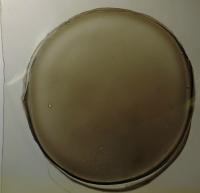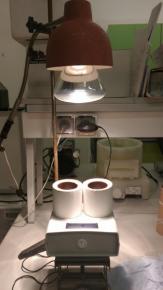Graphene infrared radiation shielding

Left: a microscope image of graphene oxide flakes; right: a microscope image of reduced graphene oxide flakes coated with iron oxide nanoparticles; photo: IR-GRAPH Project Archives
Scientists of the Warsaw University of Technology Faculty of Chemistry and Process Engineering use graphene oxide and graphene-related compounds to develop new materials for infrared radiation protection. Their IR-GRAPH Project was funded by the National Centre for Research and Development (NCBR).
“We want our materials to act as a barrier to both heath absorption and release,” says Marta Mazurkiewicz-Pawlicka, Ph.D. Eng., who supervised the work. “They are composites. We create them of polymers, using two types at this time. We use graphene materials with added metal oxides, such as titanium oxide, as the filler.”
Such a combination provides efficient screening. “Graphene materials are added to absorb radiation while metal oxides are supposed to disperse it,” explains the researcher.
Competitive material
The market already offers, e.g., window films for radiation protection. However, the materials developed by the scientists of the Warsaw University of Technology can compete with them. “They contain about 5% of added filler to reduce the temperature by a few degrees Celsius,” says Doctor Mazurkiewicz-Pawlicka. “We obtain similar results by adding 0.1%, that is 50 times less, of the filler.”
But for now, the team is focused on the materials alone rather than on specific applications. And potential applications are quite easy to see, just to mention windows as well as façades or even fabrics. The materials would protect against heat losses in winter and they would prevent overheating in summer.
For buildings or vehicles, that could mean an alternative to the now common air-conditioning systems, which as we know are extremely energy-intensive. The greater the desired modification of the ambient temperature in a room, the more energy is needed to achieve it. A less energy-intensive support would bring savings in the budget and benefits to the environment.
Looking into the future
Our scientists have carried out short-term tests. The results are promising but still a number of aspects must be investigated further, e.g. the polymer performance under UV radiation or at elevated temperatures or at a modified humidity. It is important to test the existing solutions both under various conditions and over a long time. Such testing could be done in a climatic chamber where a material sample could be placed and monitored.
“For instance, we have to work on the color to be able to use our materials in window films as the current color, which is in shades of grey, obscures visibility,” says Doctor Mazurkiewicz-Pawlicka. “We want to find new polymers that could be used as warp in our materials.”
A collaborative act
The team led by Doctor Mazurkiewicz-Pawlicka included Leszek Stobiński, Ph.D., D.Sc., Artur Małolepszy, Ph.D. and a group of students working on their engineer’s or master’s theses under the project. Members of the Chemical and Process Engineering Student Research Group also made a contribution. “They have built a device to measure how efficient our films are,” says Doctor Mazurkiewicz-Pawlicka. “It comprises an infrared lamp and a sensor which measures the degrees of temperature reduction.”
The WUT scientists closely collaborated with Tatung University, Taiwan, under the IR-GRAPH project. They also received support of the University of Warsaw Faculty of Physics. “Faculty Dean Prof. Dariusz Wasik and Andrzej Witowski, Ph.D., D.Sc., are experts in solid-state physics and they have carried out spectrometer measurements for us”, says Doctor Mazurkiewicz-Pawlicka.
Why IR screening?
Graphene is mainly associated with electronics and automation applications. Graphene use for radiation screening has not been that common yet. “There are references reporting that graphene can offer screening against electromagnetic radiation,” says Doctor Mazurkiewicz-Pawlicka. “This aspect is widely researched in the context of microwave radiation and, recently, also terahertz radiation, primarily for military applications. We thought we could investigate graphene properties for infrared radiation as this is quite an unexplored territory.
Infrared radiation has the wavelength ranging from 780 nanometers to 1 millimeter. It combines with the visible light and UV radiation to create the spectrum of sunlight. Excessive sunlight has a harmful effect on human skin. As much as 50% of sunlight which reaches the Earth’s surface is infrared radiation (which can be felt as heat). That is why IR screening is vital.
Agnieszka Kapela
Promotion and Information Office
Project duration: April 2016 to December 2018
The project is funded by the National Centre for Research and Development (NCBR) under the 3rd Polish-Taiwanese Joint Research Call.








